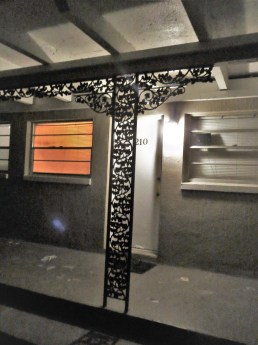cont’d from Sin City Apartments (Fox Meadows / Rivermont / Golden Shores)
In 2003, Bill Reynolds, who writes as G.W. Reynolds III, published his remembrances of being principal at Woodland Acres Elementary, Public School Number 89, in the late 1980s and early ’90s. He’d taken the job as the ninth principal in 11 years. He named his tongue-in-cheek memoir for the neighborhood’s infamous moniker.
Reynolds has published more than a dozen novels in his Jetty Man series, marketing them as if Miami novelist Carl Hiaasen wrote from Northeast Florida swamps. Hiaasen titles like Skin Tight, Skinny Dip, Strip Tease and Sick Puppy meet Reynolds titles Horny Toads, Gopher Stew, Hoochie Coochie and Holy Moly. He writes about trailer park murders and hunting camp honor codes. His collection of stories about administering an elementary school he calls Sin City.
Woodland Acres Elementary School was built before this subdivision called Oakwood Villa Estates took the nickname “Sin City” from the apartments “down in the dip” on Hare Avenue, a block behind the school.
Reynolds begins his book with four teenage boys, himself and friends in the late 1960s, driving toward town from Jacksonville Beach, detouring to “Sin City,” where “real women” walked the streets “lookin’ for men to buy sex.” If the boys thought they’d find Las Vegas, which more famously bore the same nickname, what they saw instead, Reynolds writes, “was true southern poverty, dirty children out too late at night, pit bulls barking from behind chicken wire fences and darkness. It was a darkness I was sure never lifted.”
Two decades later, Reynolds was principal of Sin City’s elementary school, where he describes: pregnant fifth graders; a couple who killed a dog with a pitchfork in the school parking lot; “crack babies,” those children born with “prenatal cocaine exposure,” when Jacksonville was called Cracksonville, who had just become school-age; a father who camouflaged his face and attached his son to a tree in the neighborhood woods for target practice with bow and arrow; a woman who hid in the bushes and forced children walking to school to eat cigarettes; a drunk Boy Scout leader; dead newborns found in nearby dumpsters; a single-toothed old man who molested his fifth-grade granddaughter to make sure she didn’t have a venereal disease.
What’s most disturbing about reading Sin City is realizing that this neighborhood of decades of urban legends is so similar to semi-rural yesteryear-suburbs all over Jacksonville. What’s most shocking is the ordinary-ness of Sin City. Oakwood Villa Estates, or Woodland Acres, sounds much like the neighborhood where I grew up on the Westside and neighborhoods I’ve known in every cardinal direction surrounding the city center: mostly “redneck,” with a large poor black minority, and enough resentment toward the very idea of education to make elementary school principals fear for their lives. In fact, that describes the Jacksonville that raised me.
The image of “drunk shirtless rednecks fighting in the streets” that makes Paul Sanderson laugh is tame beside the impression with which Reynolds leaves his readers.
There’s the mountain-sized dad who enters classrooms unannounced to shout at teachers, trying to conduct class, about how they shouldn’t teach “this Martin Luther King crap,” demanding, “What about teaching our children about” Confederate generals Robert E. Lee and Jeff Davis, “the real heroes in history”?
Then the Spearing Brothers, two adult “good old boys” wearing cowboy boots, enter a third grade classroom to stand over an eight year old black boy, threatening to beat this “little nigger’s ass,” one of them claiming, “That little nigger pushed my boy in the ditch.”
Not much later, one brother has tied a neighborhood flasher, pants down, to a post on his front porch, beaten him to pieces, and coerced little girls from the school to walk past the degraded exhibitionist to see what justice the Spearings have wrought. The other brother’s been arrested after driving his van around the neighborhood for weeks and asking elementary school girls to step inside.
Some neighborhood residents say the stories in Reynolds’s book are true, that they recognize the characters, though Reynolds changed the names. Others say the book’s “full of lies.”
Karrina Bell says, “Fuck that man and his book! He wrote about the death of my brother.” Reynolds calls Karrina’s brother “Mike” in the chapter “Death of a Young Astronaut.” He calls Karrina “Karri.” He writes of her brother’s brain tumor and says their mother smoked crack.
William says he’s read the book, tells Karrina, “I recognized what you’re talking about.”
“Thank you, William,” she says. “You know me. You know it’s bullshit. And your sister was my brother’s best friend.”
“Sure was,” William says. “I’ll never forget your brother. And I’ll never forget your mom.”
When one longtime neighbor says Reynolds was his principal, but doesn’t like what Reynolds wrote about his uncles, I ask him if what his former principal wrote is true. Did his uncles really come into a classroom, shouting racist epithets, and threaten to assault a child? Did they tie the exhibitionist to their front porch and expose him further to schoolkids? Did “Walter” drive a van around the neighborhood, trying to pick up little girls?
He answers, but says if I quote him, there’s going to be trouble. I’ve come to these streets with a feeling of strange childhood solidarity, the sense of coming from a place that branded its children unjustly. I don’t wish to violate that compact. Most of the uncountable voices speaking “Sin City” to “Sin City” will remain always in “Sin City,” whatever that nickname, fair or unfair, means to its citizens.
cont’d Sin City Swan Song












